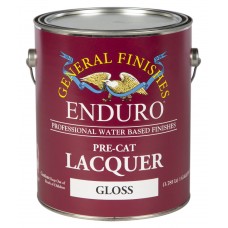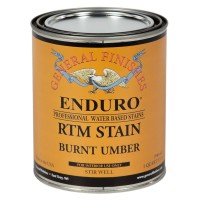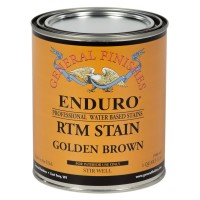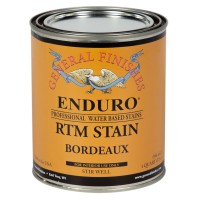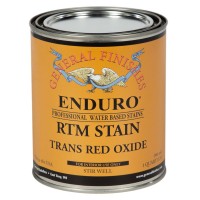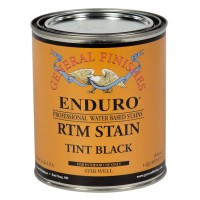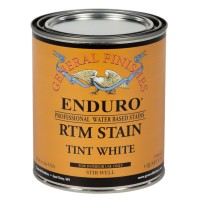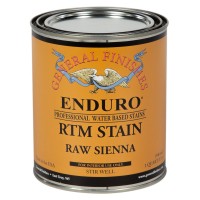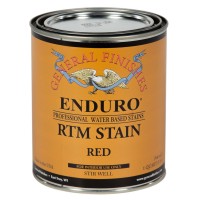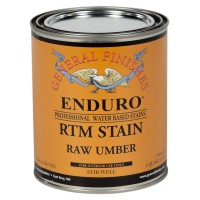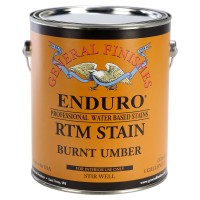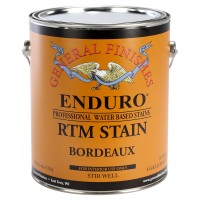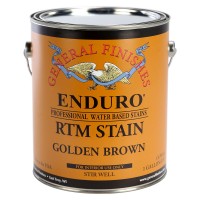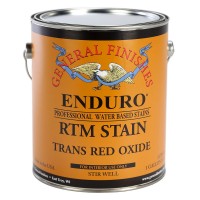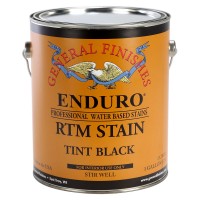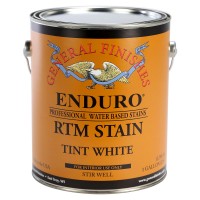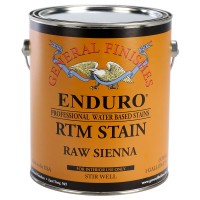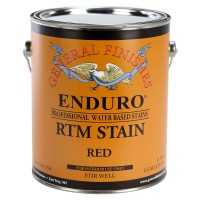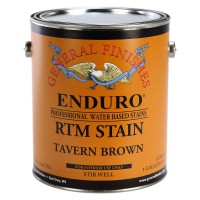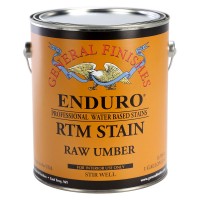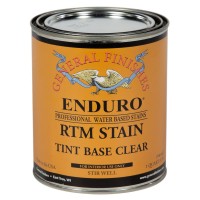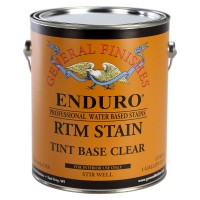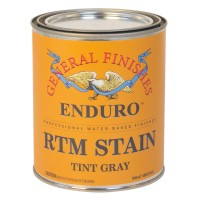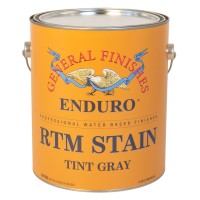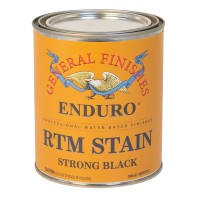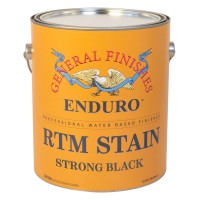Pre-Cat Lacquer Gloss - 3.785 litre
General Finishes water-based Pre-Cat Lacquer wood finish uses new technology in the polymer manufacturing process. This novel formula produces a smaller and smoother polymer particle, which translates into a big increase in film clarity. In addition, the chemical, water and yellowing resistance are superior to competitors, waterborne or solvent.
Step 1: Preparation
All wood projects require preparation sanding, and all existing finishes require prep cleaning and sanding. If you skip this critical step, your finish may fail.
Preparation for Raw Wood or Raw Wood Projects That Are to be Stained
See the GF video: How to Prep Sand Raw Wood
- Sanding Schedule: 120-grit followed by 150- or 220-grit sandpaper.
- Remove dust with a water-dampened rag or oil-free tack cloth.
- Let dry completely before applying GF product.
- Do not over-sand with fine-grit sandpapers; this will close and seal the wood grain, preventing ideal colour absorption.
- Do NOT use steel wool with water-based finishes; the particles will get trapped in the finish and rust.
Preparation for Projects with an Existing Finish (Sealed Surface)
For high-use areas with heavy grime build-up and oil from hands, give your project a deeper cleaning.
See the GF video: How to Prepare Existing Finishes
- Scuff clean with a Scotch Brite pad and a 50:50 mix of denatured alcohol and water. Dry 1-2 hours. Avoid cleaning with products containing phosphates (salt), which can linger in the substrate and produce a white haze. If your project requires a deeper cleaning, see Power Prep Cleaning Highly Used Existing Finishes below.
- Sand lightly with a fine-grade (220-320) foam sanding pad or 400-grit sandpaper.
- Remove dust with a non-sticky tack cloth or a water-dampened rag.
- Let dry completely before applying General Finishes product.
Power Prep Cleaning Highly Used Existing Finishes
For high-use areas such as kitchen cabinets or table tops with heavy grime build-up and oil from hands, give your project a "Power" clean.
See the GF video: How to Power Prep Existing High Use Finishes for Stain or Paint
- Scrub clean with a detergent, such as Spic and Span or Dawn, using a Scotch Brite pad.
- Rinse well with water.
- Scrub clean with a Scotch Brite pad and a 50:50 mix of denatured alcohol and water. Dry 1-2 hours.
- Sand lightly with a fine-grade (220-320) foam sanding pad or 400-grit sandpaper.
- Remove dust with a non-sticky tack cloth or a water-dampened rag.
- Let dry completely before applying General Finishes product.
Alternative Cleaning Solutions For Existing Finishes (Not as aggressive or effective as denatured alcohol; requires rinsing.)
- 50:50 mix of bleach and water
- 50:50 mix of vinegar and water
- Mineral spirits can be used when working with water-based products, but only if the surface is thoroughly rinsed and allowed to dry for 72 hours.
- If you use with products containing phosphates (salt), which can linger in the substrate and produce a white haze, be sure to rinse thoroughly.
Step 2: How To Apply General Finishes Pre-Cat Lacquer
General Finishes Enduro Pre-Cat Lacquer Application Steps
- Stir topcoat to reincorporate solids that have settled to the bottom of the can before and throughout the application process.
- If desired, thin with 10-15% distilled water or General Finishes Extender. Extender will improve flow and levelling and increase open time, which is helpful in dry climates.
- Apply 3 coats to interior trim, moulding, doors, low- or gentle-use furniture. Additional coats will not improve durability.
- Spray application: Before spraying, strain topcoat through a fine-mesh filter. HVLP: 1.1mm-1.3mm spray tip, medium air cap. Verify tip sizes with your equipment supplier. See our general guide for spray tip sizes. Keep your gun at a 90* angle, 15 - 20cm (6-8") from the surface. On large, flat areas, use wet, even patterns 15 - 20cm (6-8") wide. For narrow surfaces, reduce the fan pattern to 5 - 8cm (2-3") wide to reduce overspray. Overlap each pass 25% to conceal lines. Wear a mask and work in a ventilated space. Read here for more information on spraying techniques.
Face frames on cabinets: Enduro professional products are engineered to be spray-only but can be successfully applied to cabinet face frames or edges with a pad or small, cabinet-specific roller such as Whizz Velour brand. Larger areas may not level with a hand application. ALTERNATIVE: Use the same sheen of General Finishes High Performance Topcoat on areas that must be brushed. - If a faster build is desired over raw wood, use General Finishes Sanding Sealer for the first 1-2 coats, followed by 2 coats of High Performance Topcoat.
- Dry 2+ hours between coats in ideal conditions: 70*F 20*C; 50-70% humidity. Be sure to allow adequate dry time. You can tell if a water-based finish is dry if it forms a powder when lightly sanded with a fine-grade (220-320) foam sanding pad or 400-grit sandpaper. If in doubt, wait longer. Rushing the dry time can cause "blush," which is clouding in the finish due to moisture trapped between the layers.
Increase dry time if:
- Humidity is over 80%
- 3+ coats are applied
- Thick coats are applied
- Applying over an existing sealed finish
- Applying over products from other brands
- Layering General Finishes water- and oil-based products:
Water over oil: Let oil-based products dry 72+hr before applying water-based products
Oil over water: Let water-based products dry 24+hr before applying oil-based products
- To accelerate dry time in humid conditions, add General Finishes Accelerator and work in a space with good ventilation and air movement. If you decide to re-coat before the recommended time, test dryness. - Finish sand between coats with a fine-grade (220-320) foam sanding pad or 400-grit sandpaper to improve smoothness and adhesion.
- Remove dust with a vacuum, oil-free tack cloth or clean, water-dampened rag before re-coating.
Cure Time
Water-based finishes cure and harden for full use after 21 days in ideal conditions. Avoid placing heavy objects on surfaces that have not completely cured. Treat gently, and do not clean with commercial products during the curing period.
Tinting & Toning with Pre-Cat Lacquer
When tinting, we recommend using General Finishes Enduro Poly or High Performance Topcoat for tinting instead of Pre-Cat Lacquer because they have higher solids.
When toning, add up to 10% General Finishes Dye Stain, General Finishes Water Based Wood Stain, General Finishes Ready-to-Match (RTM) Stain, or Trans Tints. To deepen the colour, add a second coat.
Yellowing & Clear Topcoat
As is true of most "water-white" topcoats, General Finishes water-based topcoats dry clear over non-reactive substrates, such as plastic or metal, except General Finishes Enduro-Var, which ambers. When white paint sealed with a water-white topcoat is applied to something as unpredictable as wood, all bets are off and the reason for yellowing is often unknown. It can be caused by topcoat activating tannins in raw wood or aniline dyes, stains, or contaminants in a pre-existing finish. This is most evident when using BRIGHT WHITE paint and most prevalent in sculpted details of furniture where the topcoat can collect, intensifying colour change to an unacceptable level.
There is no reliable way to predict whether yellowing will occur and to what degree. Every existing finish is different and we rarely know the finishing provenance on an existing piece. Every tree is different and every piece of wood is unique. Raw wood can bleed tannins immediately after the topcoat dries or months later with seasonal temperature changes. Oak, pine, mahogany, and douglas fir are particularly prone to bleed-through.
Summary
- Whites have a lower “hide” quality and are more transparent than most other colours. Nearly all bright whites require additional coats to achieve the desired colour and minimize colour variation. This can increase the cost of paint finishing. Always include a clause in your contracts addressing the need for additional coats to achieve coverage.
- All bright white paint will yellow slightly with time, with or without topcoat. You have probably tried to touch up white woodwork in your home after several years and noticed the new paint is brighter.
- The underlying finish or wood species can affect the final colour of light paint.
- Details and inside corners are difficult to cover with any paint colour, but it tends to be more noticeable with whites. This is a naturally occurring phenomenon in paint application and does not necessarily constitute a defect in the paint finish or your technique.
- The more porous the paint, such as General Finishes Chalk Style Paint, the more likely that yellowing will occur. The topcoat is seeping through the spaces caused by the larger particles of filler that give Chalk Style Paints their texture.
Tips to Prevent Yellowing
- If it is a low-use project, use a premium white paint that is self-sealing and does not require a topcoat. A clear topcoat is not required on General Finishes Milk Paint for increased durability, as it is a self-sealing, exterior-rated coating with high durability and chemical and water resistance. However, topcoats do provide a smooth surface that is easier to clean and boosts durability for high-use projects, such as tabletops and kitchen cabinets.
- Use a professional spray such as General Finishes Enduro White Poly. It has "increased topcoat properties," is a standalone finish when 3 coats are applied, and does not require sealing with a topcoat.
- We recommend using General Finishes Stain Blocker, an engineered chemical barrier, to prevent persistent bleed-through for interior-use projects.
- Stain Blocker does not adhere to melamine cabinet veneers.
- Stain Blocker cannot be tinted. - Always test your project's ENTIRE finishing schedule (from cleaning to topcoat) on an inside door or a more hidden area of the piece. This will not help if the yellowing occurs later, but at least you will know if there is an immediate problem.
- Avoid painting period furniture, such as a 1940s serpentine mahogany desk, with light colours. The pieces were often finished in stain that contained aniline dyes, which cast a pinkish bleed-through under light paint. Not every piece of furniture is suitable for upcycling with a light paint colour. Pine, mahogany, and furniture of the 1940s and 50s are a red flag.
- Last, not all manufacturers' topcoats are compatible with other finishes and may react with a colour change. Always follow best practices by not rushing, and testing to your satisfaction first.
Knots
Knots in wood tend to bleed and are dense, making paint and stain adhesion a challenge. Stain Blocker may improve adhesion and prevent bleed-through for painting projects. Pine knots are especially difficult to cover with white or light paints. If you decide to paint over them, apply 3 coats of Stain Blocker first; however, we cannot guarantee adhesion or bleed-through blockage. You are better off using a dark paint on pine.
Cleanup of Water Based Products
Application tools and materials containing water-based products can be cleaned with soap and water immediately after use.
Product Spills
Spills may be able to be removed from fabric and carpet if cleaned immediately with soap and water.
Storage of Water Based Products
Life of Product
Water-based products do not last forever, even when unopened. General Finishes products are best used within 1 year of the manufacture date listed on the bottom of the can. The life of the product may be extended with proper care and storage.
Settling
Gravity can cause some solids to settle on the bottom of the can and slight separation on the top. This is normal. If working with older paint, use paint mixing attachment on a drill. If the solids dissolve and clumps smooth out after mixing from the bottom, the product is in good condition for use.
Storage Tips
See GF video tutorial: Tips on Storing Leftover Finishes
Water-based finishes crystalize and form a skin due to evaporation when the air-tight seal on a can is broken at first use. The following best practices will increase the life of your product:
- Pry open sealed lids with a paint can opener by hooking under the lid's rolled edge. The use of a screwdriver can disfigure the rim and lid, impairing a complete seal.
- Keep lid closed while working. Pour what you will use into a bowl, paper cup, or plate, and close can lid as you work.
- Clean the chime of the can thoroughly with a paper towel before closing to create a complete seal. Paint in the chime can be minimized by using a pouring lid, such as Fitsall. Avoid wiping used brushes on the lid.
- Pound the lid in place using a rubber mallet to avoid distorting the chime or lid. Dents in the lid from direct contact with a hammer can impair a complete seal. Alternatively, place a flat piece of wood over can lid and firmly pound shut.
- Store in moderate temperatures. Avoid temperatures below 50*F/10*C or above 80*F/26*C. Frozen and heat-damaged product cannot be revitalized. Temperature-controlled spaces, such as a basement, are ideal for storage. Do not store product in an attic, garage, in direct sunlight, or next to something warm like a water heater or furnace.
- Store can upside down to create a liquid seal, minimize evaporation and reduce the chance of crystallization. Decant remaining product from the can before stirring.
- Decant leftovers to a smaller container when the finish is almost used up. Alternative storage containers for water-based products are plastic FIFO bottles or glass bottles. Do not fill metal-lidded containers completely to prevent them from rusting.
The following water-based product mixtures can be stored:
- Product thinned with up to 15% General Finishes Extender or General Finishes Accelerator can be stored, with the exception of thinned General Finishes Water Based Wood Stain.
- Mixtures involving colours & sheens within the same product line, such as:
- High Performance Satin + High Performance Gloss
- Snow White Milk Paint + Coastal Blue Milk Paint
- Amber Dye Stain + Merlot Dye Stain
The following product mixtures should NOT be stored:
- Any water based product with thinned tap water; water often contains bacteria that will adversely affect stored paint.
- Topcoat + Stain or Paint
- Milk Paint + Chalk Style Paint
- Water Based Wood Stain + Dye Stain
Furniture Care and Maintenance
Cure First
You have just finished applying a fine furniture finish. Treat gently until the paint or topcoat have fully cured. Allow 21 days for a water-based finish to cure and 30 days for an oil-based finish to cure before cleaning.
Regular Cleaning and Maintenance
- Remove dust with a water-dampened cloth. Dust can build up over time and may scratch or dull finishes if not removed regularly.
- Remove fingerprints, cooking fumes and smoking residue with mild soap and water. These contaminants will not harm the finish, but they accumulate on surfaces and dull the original lustre.
- As with all fine furniture finishes, avoid using furniture polish, cleaners or dusting sprays that contain silicone, alcohol, ammonia and anything acidic. Exception: We have successfully cleaned with Clorox wipes.
- Clean up water, alcohol and food spills in a timely manner and use placemats & coasters to protect the finish.
- Future finishes or touch-ups may not adhere properly or perform as desired over a contaminated surface. Some contaminants, such as silicone, seep through finish into the wood and often cannot be removed.
- Avoid excessive exposure to direct sunlight, high temperatures or high humidity. These can damage furniture and finishes.
Warnings and Warranties
Limited Warranty
General Finishes products must be tested to your complete satisfaction before using, including compatibility with other manufacturers products. General Finishes will be responsible only for the cost of our products and will not be responsible for any costs such as labour, damage, or replacement costs.
Contamination and Compatibility
Our finishes are engineered as a system and are compatible with each other. General Finishes cannot guarantee an ideal refinish when applying our products on top of or combined with another company's products or over surfaces that have been in contact with waxes, polishes or sprays containing contaminants such as silicone. Test for adherence and aesthetics before beginning.
Danger: Contents are COMBUSTIBLE. Keep away from heat and open flame. Application materials or other waste soaked with this product may spontaneously catch fire if improperly discarded. Immediately after use, place rags, steel wool or waste in a sealed, water-filled, metal container. Dispose of in accordance with local fire regulations.
CAUTION: Contains ALIPHATIC HYDROCARBONS. VAPOUR HARMFUL. Use only with adequate ventilation. DELAYED EFFECTS FROM LONG-TERM OVEREXPOSURE. Contains solvents which can cause permanent brain and nervous system damage. Intentional misuse by deliberately concentrating & inhaling the contents can be harmful or fatal.
Warning
If you scrape, sand, or remove old paint, you may release lead dust. LEAD IS TOXIC. EXPOSURE TO LEAD DUST CAN CAUSE SERIOUS ILLNESS, SUCH AS BRAIN DAMAGE, ESPECIALLY IN CHILDREN. PREGNANT WOMEN SHOULD ALSO AVOID EXPOSURE. Wear a NIOSH-approved respirator to control lead exposure. Clean up carefully with a HEPA vacuum and a wet mop. Before you start, find out how to protect yourself and your family by contacting the National Lead Information Hotline at 1-800-424-LEAD or log onto www.epa.gov/lead.
Do not swallow; first aid: drink water to dilute product. May cause eye and skin irritation; first aid: flush eyes thoroughly with water.
FIRST AID: In case of eye contact, flush thoroughly with large amounts of water for 15 minutes and get medical attention. For skin contact, wash thoroughly with soap and water. In case of respiratory difficulty, provide fresh air and call physician. If swallowed, do not induce vomiting. Get medical attention immediately.
Warning
Do not swallow; first aid: drink water to dilute product. May cause eye or skin irritation; first aid: flush eyes thoroughly with water.
Furniture Care and Maintenance
Cure First
You have just finished applying a fine furniture finish. Treat gently until the paint or topcoat have fully cured. Allow 21 days for a water-based finish to cure before cleaning.
Regular Cleaning and Maintenance
- Remove dust with a water-dampened cloth. Dust can build up over time and may scratch or dull finishes if not removed regularly.
- Remove fingerprints, cooking fumes and smoking residue with mild soap and water. These contaminants will not harm the finish, but they accumulate on surfaces and dull the original lustre.
- As with all fine furniture finishes, avoid using furniture polish, cleaners or dusting sprays that contain silicone, alcohol, ammonia and anything acidic. Exception: We have successfully cleaned with Clorox wipes.
- Clean up water, alcohol and food spills in a timely manner and use placemats & coasters to protect the finish.
- Future finishes or touch-ups may not adhere properly or perform as desired over a contaminated surface. Some contaminants, such as silicone, seep through finish into the wood and often cannot be removed.
- Avoid excessive exposure to direct sunlight, high temperatures or high humidity. These can damage furniture and finishes.
Technical Data Sheet (TDS)
Safety Data Sheet (SDS)
Enduro Pre Cat Lacquer Flat - 2018-06
Enduro Pre Cat Lacquer Satin - 2018-06
Enduro Pre Cat Lacquer Semi-Gloss - 2018-06
Enduro Pre Cat Lacquer Gloss - 2018-06

